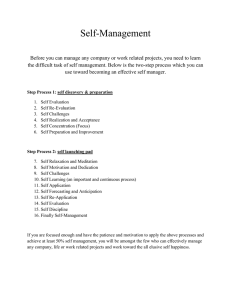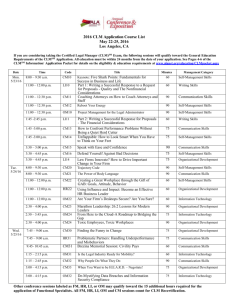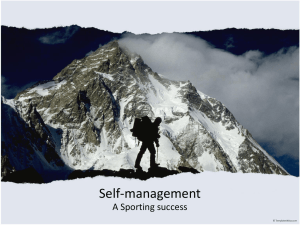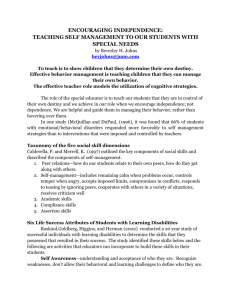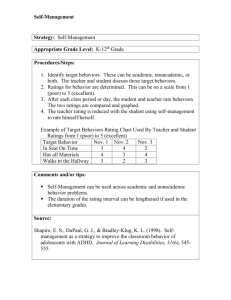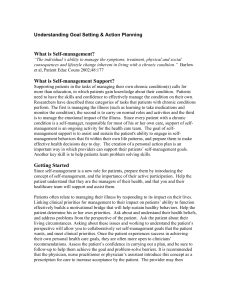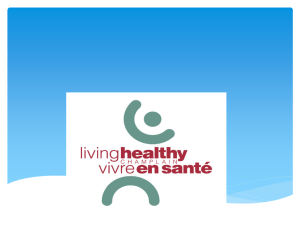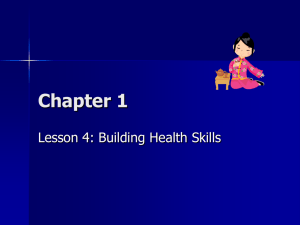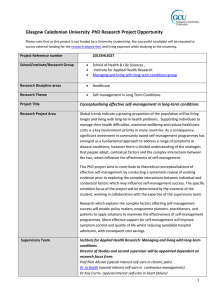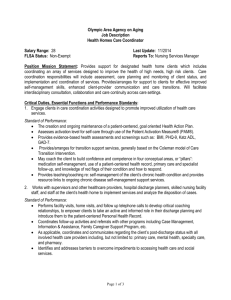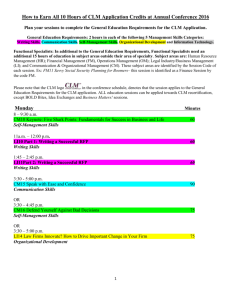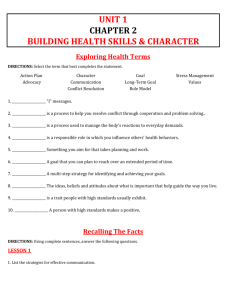Managers as Change Leaders - Network for Social Work Management
advertisement
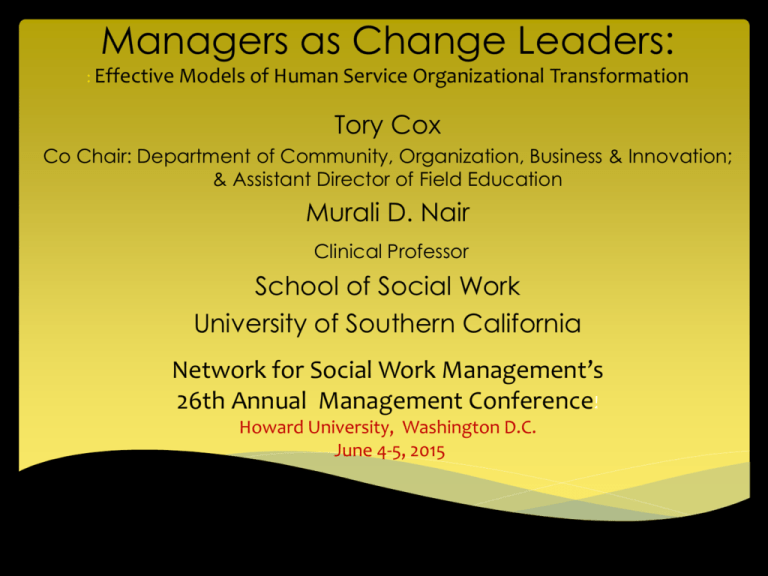
Managers as Change Leaders: : Effective Models of Human Service Organizational Transformation Tory Cox Co Chair: Department of Community, Organization, Business & Innovation; & Assistant Director of Field Education Murali D. Nair Clinical Professor School of Social Work University of Southern California Network for Social Work Management’s 26th Annual Management Conference! Howard University, Washington D.C. June 4-5, 2015 Location: Blackburn 148/150 Theme: Strategic Management | Presentation Type: Workshop For transformational change to take place, innovations need to occur along two dimensions simultaneously – technical and organizational. Utilizing presented and real-time case studies from attendees, participants will explore technical and organizational innovations. CHANGE “Organization” “Change” “Organizational Change” DISCUSS What changes have you been a part of or have witnessed take place in your organization? Adaptive Challenge, Part 1: Technical Innovation Product, technological, or structural changes Introduction of new technologies/products/services Changes how people interact with each other, reduces isolation Propels efficiency of communication or intervention Adopts evidence-based practice models, for ex. Restructuring lines of reporting and supervision Ex: flat hierarchy, erasing siloes, self-management, Holacracy Process/protocol changes Design to maximize efficiency of service delivery INNOVATION Technical Innovation Driven by market demands Works to fulfill market demands DISCUSS How can this type of innovation, which is usually applicable to economic sectors and R&D, apply to social service organizations? Adaptive Challenge, Part 2: Organizational Innovation Organizational Innovation Complex Division of Labor (diversify) Organic Structure (decentralize) High-Risk Strategy (dive in) Organizational Innovation Non-technical process innovation “Culture eats strategy for lunch” (Drucker) Reinventing organizations – Frederic Laloux Self-management – purpose, peer-importance, adults High complexity – hierarchy archaic (N. Korea/Cuba) Holacracy – distributes leadership throughout organization Book out June 2, 2015 Wholeness – integrity of person Evolutionary purpose – let organization naturally go toward… Millennials – what can we learn from these catalysts? Replaces “how can we possibly manage them” Mixed methods – work space restructuring (open space) Case Study “Culture is as important as the bottom line” (Zappos’ T. Hsieh) Delivering happiness – focus of leadership Work-life integration (not balance, not boundary) “Be the same person at home or work” “Most people leave something of themselves at home when they go to work each day” Self-organization, self-management Bought by Amazon for $1.2 billion in 2014 Harvard U. Human Services Summit Change needed in human services orgs: efficient, effective, creative Business Models: Regulative – functional, audit-ready – reduces mission drift Collaborative – eliminates siloes within org, some sharing outside Integrative – seamless, customization, community as decision makers, treatment regardless of organization Goal: Generative – adaptive, evolving & modular Flatter, leaner, network and ecosystem focused Systems-wide information sharing Conditions for predictive analysis / policy & program innovation Co-create solutions within community, other orgs, networks New client who wants to be part of the solution Case Study Allegheny County, PA DHS (Integrative) Multi-need clients exhausting resources Technical innovation: Share data across organizations and align silo departments under umbrella of DHS Organization Innovation: Case workers from multiple organizations work together to solve problems, family-centric outcomes occur through customization What if those work groups managed themselves? Discuss: what might you learn from this example that will help you guide change in your organization? CHANGE Organizational Change as a Process (Lewin) Unfreezing, Changing, Refreezing Bridges Model of Transition Grieving, Time of Uncertainty, Acceptance Horse Assisted Change Management Video https://www.youtube.com/watch?v=Jj-QhF_i9VQ • Discovery: What gives life? The best of what is. • Dream: What might be? Imagine what the world is calling for • Design: How can it be? Determining the ideal • Destiny: What will be? How to empower, share leadership, create self-management, learn and adjust, improvise, and innovate Discuss: How do these models change our plans to manage change in our organizations? CHANGE AGENTS Steps Towards Stimulating and Implementing Change (Galpin, 1996) 1. Define the Need to Change 2. Develop a Vision 3. Organize Teams – diverse skill sets (StrengthsFinders) 4. Incorporate Cultural Aspects that will Sustain Changes 5. Develop Skills Needed to Lead Change Discuss – who does these in your organization? CHANGE AGENTS Guidelines to Understand the Change Process (Fullan, 2002) 1. Innovate Selectively but Coherently 2. Constantly Help Others Find Meaning and Commitment 3. Facilitate Collectivity 4. Address Resistance as an Opportunity 5. Re-culture DISCUSS As change agents, are you aware of these guidelines? Have you ever followed these in your own change processes? Case Study USC School of Social Work Technical innovation – curricular change, organizational restructuring, new working groups and lines of leadership Organizational innovation – incubators, innovators-inresidence, curricular design teams En vivo experiment happening right in front of us Reflection on organizational innovation: Diversify, decentralize, & dive in Complexity of labor drives employee morale up CHANGE AGENTS Leadership (Northouse, 2013) 1. 4. Leadership is a Process 2. Leadership Involves Influence 3. Leadership Occurs in Groups Leadership Involves Common Goals DISCUSS Which components of leadership have you witnessed, either as a leader yourself or in working under a supervisor? LEADERSHIP THEORIES Contingency theories of leadership Institutional Leadership Theories Institutional Leadership Theory Core function is to protect institutional integrity Anthropological Leadership Model Core function is to improve employee evaluative knowledge Values, effects of actions, motives = organization unity DISCUSS Take us through the transformation from ILT to ALM and its implication on transforming managers into effective leaders? Change Agents Strengths of Effective Organizational Leaders Ambition Architect Creativity Dedication Fairness Learning * * * * * * Openness Perseverance Realism Self-Confidence Steward Teacher DISCUSS What can you add to this topic? What are some characteristics, skills, and qualities of successful organizational change agents that aren’t listed here? Lessons of Leadership The Way of the Owl (Rivers, 1997) lessons: Resistance is inevitable – handle with grace and skill A skilled enemy is a wonderful gift Adapting to one’s environment – letting go of control Dare Greatly (Brown, 2012) Vulnerability – What you admire in others but are ashamed of in yourself Move toward it (don’t be afraid) How would we act if we had no fear? Forget all you know Why do you follow someone? Does it have to be a someone? When have you followed something? Which is more powerful? SUMMARY Move toward employee ownership and empowerment and let go of the need to control the change. Treat adults as adults. Use thoughts on resistance to move past it. Tackle large ideas and create idea-pooling opportunities Spur innovation by changing interactions Notice: is anyone following? DISCUSS What other takeaways do you have from this discussion?
